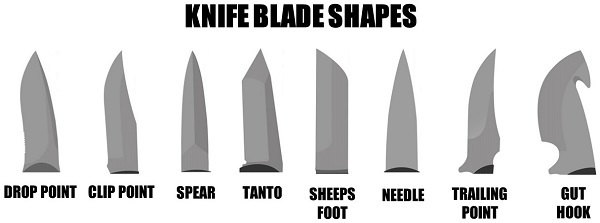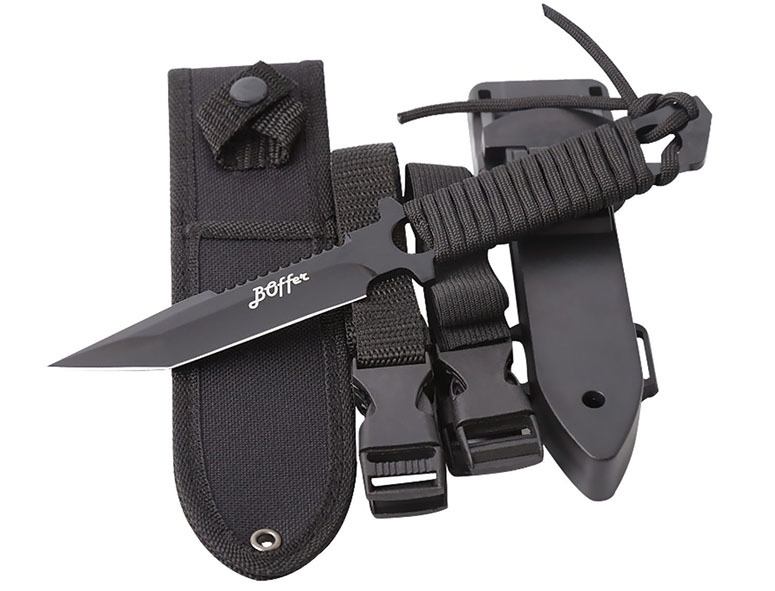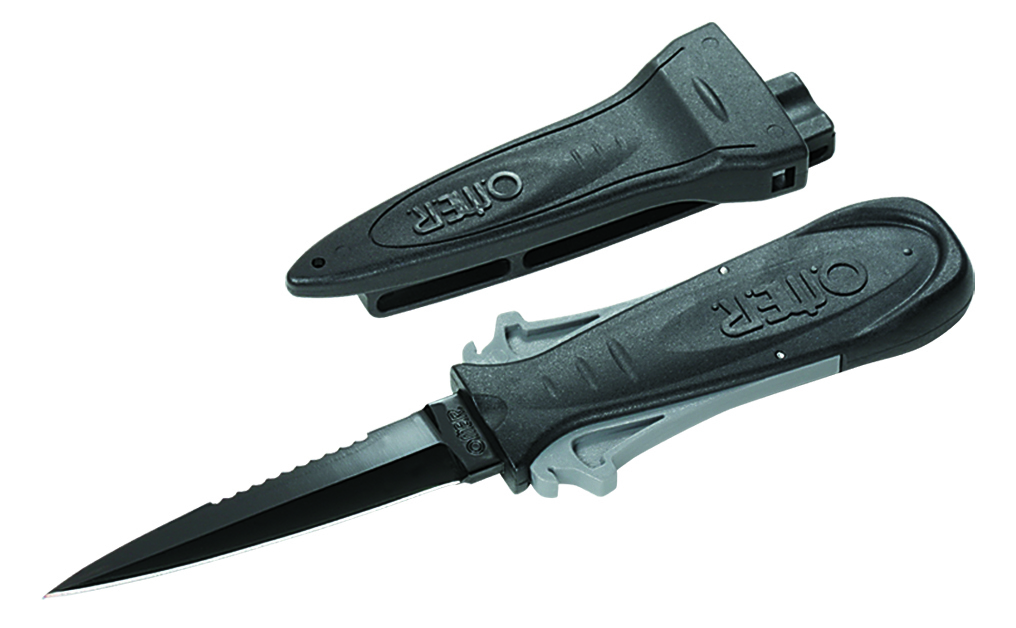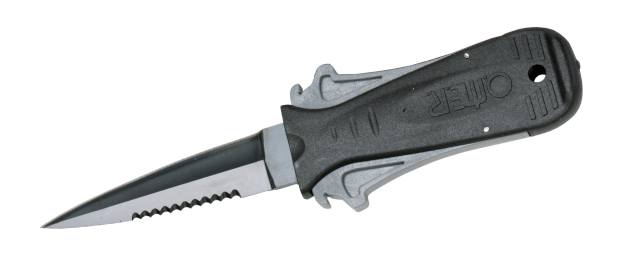The trusty spearfishing knife has probably saved the lives of more divers and hapless sea creatures than we care to admit. This is definitely one item that you should never get in the water without.
A good spearo knife is an indispensable piece of equipment and something that you can use for a multitude of reasons: from cutting a rope or float-line, dispatching a fish quickly and humanely, protecting yourself from predators or even saving a helpless sea creature.
I’m sure you’ve heard of similar stories…
If you think the last two examples sound a bit far-fetched then google “Hawaiian family saves whale shark” or for a heart-pounding video search for “Spearfisherman fends off two sharks”.
Just a quick warning this article did get a little out of hand and is quite lengthy. For easy navigation use the index below.
If you are just interested in our top 5 recommended spearfishing knives then have a look at the list here or the brief reviews further below.
What makes a great spearfishing knife
There are a couple of things to consider when you are shopping for the best spearfishing gear. Let’s start at the tip fo the knife and work our way to the butt.
The Tip and Point
You get many different types of knife tips and points but the best spearo knifes have either a Spear, needle or at the very least a clip point. Any other shaped point will not be sharp enough to pierce a fish when you are dispatching it.

The Edge and Spine
With a spear or needle-point knife, you very often will have a sharp cutting edge on both sides and technically no spine.
Some manufacturers - and all of the top knives that made our list - make their knives with a smooth cutting edge on the one side and either a full or partial serrated cutting edge on the other side. Ideally, you do want at least a partial serrated edge on your knife as well since they are much quicker at sawing through heavy lines and rope. The best Clip point style dive knives will have a partially serrated edge on the spine and even a line cutter.
Blade Length
A good length for the blade of a spearfishing knife is 3 to 4 inches in our opinion. That makes for a total knife length around 8 inches. Anything longer than this might just make it awkward to carry and handle. Even the biggest fish doesn’t need more than a couple of inches at the right spot to kill it instantly. Remember it’s not about the length, it is how you use it.
The Finger Guard & Handle
Since you are very likely to be using the knife under high-stress situations and mostly in the water you should have some type of finger guard to protect your fingers and keep the knife from slipping. Most dive knives come standard with it.
The material that the handle is made from will contribute a lot to how grippy it is. Common handle material is textured hard plastic, textured soft plastic, or a combination of both. Less common, but also a very durable and grippy material is something like G10 which is a fiberglass laminate.
An ergonomic handle does help with grip but since not everyone’s hands are the same sizes we normally don't recommend them.
"Skeletonized" diving knives are a cheap option and eliminates any concerns that you might have with regards to grip durability. The ergonomics of a flat steel bar is horrible though, so many divers and manufacturers wrap the skeleton handles with paracord.

Sheath
A sheath is a must for any fixed blade knife. When it comes to diving knives the cheap ones come with clunky hard plastic sheaths and the really cheap ones with canvas sheaths.
Look for a knife and sheath that is low profile and streamlined. Having a bulky one will end up catching and getting tangled in your line - especially if you wear it around your thigh or calf/ankle.
It is also a good idea to get a knife with multiple mounting options especially if you are not yet sure where you’ll be most comfortable carrying it. The sheath should allow you to pass it through your weight belt and also come with straps that attach allow you to attach it to your arm or leg.
Material
Most diving knives are made from stainless steel but a number of manufacturers have started making knives in the more durable and slightly more expensive titanium steel.
Titanium dive knives are not only stronger and lighter but it also offers better corrosion resistance. Knives made from anything other stainless steel or titanium steel won’t last long with frequent exposure to seawater.
The most common and probably the best type of steel for diving knives are 440C stainless steel as it gives a good balance between edge retention, rust resistance and affordability.
Spearfishing vs Scuba diving knife
Most spearfishing knives would make a fine scuba diving knife but the inverse is not always the case.
The biggest difference between a Scuba and spearfishing knife is the tip/point, the blade shape and the size.
Since scuba divers don't need a sharp tip to kill fish with they often carry knives with blunt tips. Scuba divers that are afraid that they might puncture a hose, their wetsuits or themselves usually opt for these knives. Blunt tipped knives make for good prying instruments though. Perfect for dislodging rock oysters and mussels.
The average Scuba diver also prefers a clip or drop point knife instead of a spear point like most spearfisher men.
Where to carry a spearfishing knife
This seems to be an area of contention among spearos and divides them in different camps.
The three most popular positions to carry a dive knife is the:
Each position has its advantages and disadvantages and it’s very much based on personal preference. Play around with the different options and find out what works for you
Personally, I started with a knife around my ankle then moved it to my thigh before briefly having it on my arm. I finally settled with having the knife on my belt.
Around your forearm or bicep is a popular position but the biggest problem with that is that you can only reach it with the opposite hand. What happens if you hurt your hand or it’s already occupied…?
Wearing your knife around your leg eliminates this problem but causes another. Unless you have a really low profile knife and sheath it can get tangled up in your float or reel line while swimming
Wearing your knife on your belt allows you to reach it with either hand and also lessens the chance of it getting caught in your line. This does mean however that if you need to drop your belt in an emergency you will at the same time lose your knife.
As we said each position has its pros and cons.
Try out the different positions and stick to what works best for you.
How to take care of your spearfishing knife
Even if it says stainless steel it doesn’t mean you don’t need to look after it. A couple of simple steps will have your knife last much longer.
The first thing to do after every dive is to rinse your knife and its sheath in fresh water. The sheath is especially prone to trapping sand and dirt so be sure to give it a good rinse
Corrosion and rust are greatly accelerated by Saltwater so this is a must do.
After rinsing off all the sand and salt water make sure to dry the knife and its sheath with a soft cloth. It is difficult to dry the inside of a sheath so leave the knife out and let them both air dry in a safe place before putting the knife back in its sheath.
As an extra step and for better protection of your knife you can put some silicone on the blade. You can use either a silicone spray or silicone grease. If you also use your dive knife to gut or dress a fish then go for the food grade silicone spray.
It is a good habit to rinse all your gear in fresh water after every dive in the ocean.
How to humanely kill a fish with a knife
This can be an article on its own(and pretty soon it will be) but we’ll quickly address it here.
The quickest and most humane way to kill a fish that you have just speared is to insert your knife into its brain and scramble it. You can also use the tip of your spear, your fish stringer or a specially made tool like an Ike Jime spike.
A fish’s brain is located behind the eyes about as far back as the eyes are apart and at a 30 degree angle above the eyes.
To pierce it get a firm grip on your fish by grabbing it by the gill slit. Carefully place your knife, kill spike or other sharp tool on the spot where the brain is located.
Push down firmly.
The fish will flap violently as your knife enters and then go limp.
With larger fish you might have to rotate your knife a bit to kill it. On smaller fish you should take care not to stab your other hand as you do this.
Best spearfishing knives
Riffe Spearfisher's Knife
The Riffe Spearfisher's Knife ticks all our boxes. It has a spear-point blade with a razor edge on the one side and a serrated edge on the other side. The hard plastic handle with its shaped finger guard has a good feel and is comfortable in the hand. The hole in the butt of the handle allows you to add a lanyard that you can slip over your hand when you are using it.
The sheath has a big draining hole in the bottom which makes rinsing it a breeze. The sheath allows you to carry the knife on a standard 2" diving belt or around your leg by using the included straps. A nice addition to the sheath is an elastic loop that you can put over the butt of the handle to help with retention.
The knife comes in a gray and a bright orange. With its 4.5" blade it is at the maximum length we would want any knife to be. Its total length is 8.5" which is a bit too long to carry on your arm. If this is too long for your liking go for the Riffe Stubby which is essentially the exact same knife just an 1" shorter
Omer Mini Laser Knife
Omer makes some of the most beautiful and well designed spearfishing and freediving equipment there is. The Omer Mini Laser is no exception.
The mini is the smaller version of the full size laser knife and its stainless steel blade measures slightly more than 3". Its sheath is fixed on curved armband that allows you to attach it to your arm with the elastic straps that are included. That does however mean that you can't attach it to your belt or thigh. The squeeze lock retention on the knife is good and this is a brilliant kill knife for spearo's looking for something to dispatch their catch with.
Cressi Grip
The Cressi grip is a great all-round spearfishing knife and dive knife. Even though the blade on the knives do have more of a drop-point shape they still have a tip that is sharp enough to kill a fish swiftly and humanely.
The Bonus: it comes in a Titanium version which is very competitively priced. And by that we mean competing with similar use stainless steel knifes.
The sheath comes standard with multiple mounting options - from your belt to your leg and even to your hose if you scuba dive.
Morksej Dive knife by Mahi Mahi
If you are thinking that this looks just like the Omer Laser spearfishing knife then you are right.
It is unclear who copied who but this version does sell at a much lower price than the Omer. It's made from 420 stainless steel so if you take care of it it should last you a long time.
Just a fair warning and judging by the reviews online you do get what you pay for. But still, it is a popular choice among spearos who treat knives as disposables, those prone to loosing them and those on a tight budget.
It comes with rubber straps to carry the knife on your leg or arm and the sheath also allows you to carry it on your belt. A great value for money option if you don't care about the brand name.
We hoped you enjoyed and found value in our Ultimate guide to Spearfishing knives. If you did then please take a moment to share the article with your diving buddies.








